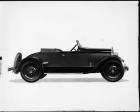|
Re: Radiator flush fluids
|
||||
|---|---|---|---|---|
|
Home away from home
|
Hope this clears up the confusion. What is common for me, is not generally widely known. Ask questions. Ok, to email if response is needed quicker. I don't visit much anymore.
The air "dams" are the sheet metal around the radiator that direct the air flow from the grill through the fins. missing(bad) or all there(good)? Rusty doesn't apply here unless rotted through/holely/bypassing. Sludge in the cooling system has to come from somewhere as it starts off clean from the factory. Usually, without sabotage/failure, it's a combination of what has been added and what develops over time from corrosion, etc. Some of that sticks to or builds up on the surface and is known as "fouling", a 'film' over the surface. When film is retarding heat transfer, it necessitates cleaning and/or purging coolant periodically. In boilers, it would be called "blow down". If you use DI/distilled water to mix antifreeze, then the inhibitor is more available as few minerals to complex from the water. Tap water minerals will remove some of the effective inhibitor level - ie; won't last as long. I've lived in places where the tap water would fill a 40 gal hot water tank in 5+ years or less with calcium and short out the heater. If you have "soft" water, less than 300 ppm TDS, fine to use. I'm on well water here, and don't trust. Don't use straight "zero-ohm" aka RO water w/o antifreeze or inhibitor added, as mentioned, as it will enhance metal ion dissolution. Requires change of materials or greater inhibition. Also ethylene glycol is an alcohol. Alcohols oxidize(hydrolyze) over time to their respective organic acids, and acid will complex the metal. Acidity increases the rate of hydrolysis(breakdown), also. You can actually test for that. It's competing with metal oxidation for air. So antifreeze more or less needs to be changed at some point, but it's a slow process without much air in the system. I've found 5 years to be very adequate, as prescribed, and not so fast as to be wasteful. If I was selling antifreeze, you'd hear a shorter interval... When I rebuilt the water pump on the Cad, the cast disc impellor was in "rough" shape and no longer made. I had to adapt to a modern open style impellor which required some machining. So if your impellor has been in there since new, it's subject to cavitation and rust and will reduce it's dimensions/edges and not be as effective as an impellor, flow rate will diminish over time - less cooling. Maybe not critical, but won't be optimum. (ChemEs(me) do pumps of all kinds all the time, both design, spec, and maintain.) But not possible to know what you car is like from 'a verge of overheat' condition. I can only speculate causes. I think the altitude is your main issue, more than fouling(guess). Otherwise, I would not have mentioned. One has to know the heat transfer coefficients of the various modes in an auto, and the water side, even fouled, is many times higher than the radiator fin to air mode. So that's altitude likely causative too as the air density lowers with altitude. Same flow volume with less mass to pick up heat. aka; double whammy. BP and mass lower. As to "weeping", that's a small crack or pore(pit) in the solder or interface or fin base metal, that's been thinned, rotted, or undermined, likely pitting, crevice, dissimilar corrosion at work - from lack of inhibitor. Leaking for short periods, like to get home or postpone repair, then a "Stop leak" addition is common. Effective, they aren't the best as can plug other small spaces equally. But I've used them a bit and successfully. Corrosion is one of the things the inhibitor is supposed to take care of, so I suspect with inattentive maintenance, they left 'spent' antifreeze in it, and it slowly worsened. Mechanical vibration can be enhanced with age from the isolator getting stiff. There's a piece of rubber under radiator bolt that dampens vibrations. If it was a pressure system, it'd probably be leaking worse. Metal expands as it heats, so the opening gets bigger and shrinks when cooled causing the intermittent flow. Usually an indication that it's time for a recore. I had similar on the '49 P and had mine recored. Getting very expensive now and the original cores are no longer available, so you have to use what's out there. A good radiator shop is a must.
Posted on: 4/13 9:55
|
|||
|
||||
|
Re: Radiator flush fluids
|
||||
|---|---|---|---|---|
|
Quite a regular
|
Thanks for the follow-ups, su8 and Fish’n Jim. I’m going to reconnect things in the next couple of days, run some Evaporust through the system and see where I can get with things, and then once that is done add some RO water and no-Rosion to run the system. I may be back with more questions as issues arise. I appreciate all the time taken to educate me on these things, I would be completely lost without help from all the people willing to share their experience.
Posted on: 4/14 9:39
|
|||
|
||||








